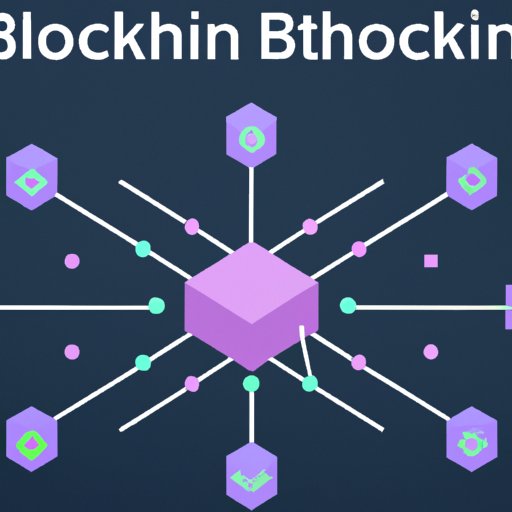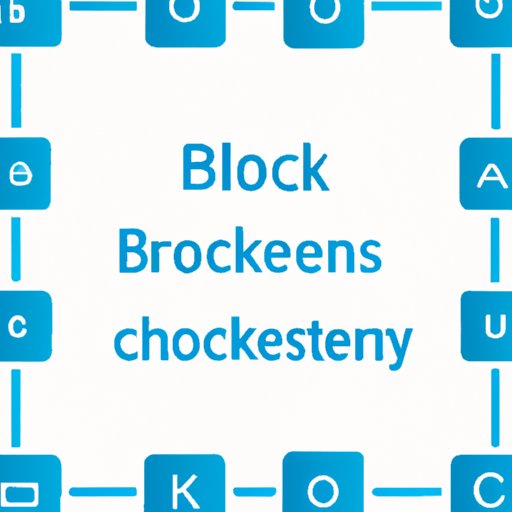Introduction
Blockchain has been generating a lot of buzz lately, as many people are intrigued by this cutting-edge technology and its potential applications. But what exactly is blockchain? In this article, we will explore the basics of blockchain technology, from its definition to its components to its benefits and potential. We will also analyze the impact of blockchain on businesses, both advantages and challenges.

Exploring the Basics of Blockchain Technology
Before diving into the details of blockchain technology, it’s important to understand its basic concepts. Let’s take a look at what blockchain is, how it works, and the different types of blockchain networks.
What is Blockchain?
In simple terms, blockchain is a digital ledger that records transactions between two or more parties. It is distributed across multiple computers and is secured by cryptography. This makes blockchain an immutable and secure system for storing data and conducting transactions.
How Does Blockchain Work?
At a high level, blockchain works by creating blocks of data that contain information about a transaction. These blocks are linked together and secured using cryptography. When a new block is created, it is added to the chain and can’t be changed or deleted. This creates an immutable record of all transactions that have taken place on the network.
Types of Blockchain Networks
There are several different types of blockchain networks, each with their own set of features and characteristics. The most common types of networks are public blockchains, private blockchains, and permissioned blockchains. Public blockchains are open to anyone and are highly secure, while private blockchains are only accessible to a select group of users. Permissioned blockchains allow certain users to access and modify the data stored on the network.
Breaking Down the Definition of Blockchain
Now that we have a basic understanding of what blockchain is, let’s take a closer look at the components of a blockchain system and the different types of consensus mechanisms.
Components of a Blockchain System
A blockchain system consists of four main components: nodes, miners, blocks, and consensus mechanisms. Nodes are computers that are connected to the network and are responsible for validating transactions. Miners are individuals who use specialized software to solve complex mathematical problems in order to create new blocks. Blocks are collections of data that contain information about a transaction. Finally, consensus mechanisms are algorithms that ensure all participants in the network agree on the validity of a transaction before it is added to the blockchain.
Types of Consensus Mechanisms
The type of consensus mechanism used in a blockchain system depends on the type of network. The most common consensus mechanisms are proof-of-work (PoW) and proof-of-stake (PoS). PoW requires miners to solve complex mathematical problems in order to create new blocks, while PoS requires users to stake a certain amount of their tokens in order to validate transactions. Other consensus mechanisms include delegated proof-of-stake (DPoS), Byzantine Fault Tolerance (BFT), and Practical Byzantine Fault Tolerance (PBFT).
Examining the Benefits of Blockchain
Now that we have a better understanding of the components of a blockchain system, let’s take a look at the benefits it offers.
Security
One of the most significant benefits of blockchain technology is its security. Because the data stored on the blockchain is encrypted and distributed across multiple computers, it is virtually impossible for hackers to gain access to the data. Additionally, because the data is immutable, it cannot be changed or deleted without the consent of the majority of users on the network.
Transparency
Another benefit of blockchain technology is its transparency. All transactions on the blockchain are visible to everyone on the network, which helps to ensure that all users are playing by the same rules. Additionally, because the data is immutable, users can trust that the data they are seeing is accurate and up-to-date.
Cost Savings
Using blockchain technology can also help businesses save money. By eliminating the need for middlemen and reducing the time needed to process transactions, businesses can reduce their overhead costs. Additionally, blockchain networks can be used to automate certain processes, such as payments, which can further reduce costs.
Efficiency
Finally, blockchain technology can help businesses become more efficient. By streamlining processes and reducing the amount of paperwork needed, businesses can save time and resources. Additionally, blockchain networks can be used to create smart contracts, which can automate certain tasks and help businesses become more efficient.
A Comprehensive Guide to Blockchain Technology
Now that we have explored the basics of blockchain technology and the benefits it offers, let’s take a look at how to set up a blockchain network and some of the key features it includes.
Setting Up a Blockchain Network
Setting up a blockchain network is relatively straightforward, but there are a few things to keep in mind. First, you’ll need to decide which type of blockchain network you want to use. Once you’ve made this decision, you’ll need to choose a consensus mechanism, such as PoW or PoS. You’ll also need to determine which nodes will be part of the network and how they will communicate with each other. Finally, you’ll need to decide how to incentivize miners to participate in the network.
Implementing Smart Contracts
Smart contracts are one of the most powerful features of blockchain technology. They are self-executing contracts that are written in code and stored on the blockchain. When certain conditions are met, the contract is automatically executed. Smart contracts can be used to automate a variety of tasks, such as payments and escrow services.
Integrating Cryptocurrencies
Many blockchain networks also allow users to integrate cryptocurrencies into their system. This means that users can send and receive digital currencies, such as Bitcoin and Ethereum, on the network. This feature can be used to facilitate payments and transfers, as well as to reward miners for their work.

Understanding the Potential of Blockchain
Now that we have a better understanding of how to set up a blockchain network and the features it includes, let’s take a look at its potential applications in various industries.
Applications in Various Industries
Blockchain technology has the potential to revolutionize a wide range of industries. For example, it can be used to create secure supply chain systems, automate healthcare records, and create decentralized energy grids. Additionally, blockchain networks can be used to facilitate the creation of digital currencies, such as Bitcoin and Ethereum, which can be used to make secure and transparent payments.
Impact on Businesses
The application of blockchain technology can also have a significant impact on businesses. For example, it can be used to streamline processes, reduce costs, and increase efficiency. Additionally, blockchain networks can be used to create secure and transparent payment systems, which can help businesses build trust with their customers.

Analyzing the Impact of Blockchain on Businesses
Now that we have explored the potential applications of blockchain technology, let’s take a look at its impact on businesses, both advantages and challenges.
Advantages for Businesses
The implementation of blockchain technology can offer many advantages for businesses. For example, it can help reduce costs, increase efficiency, and streamline processes. Additionally, blockchain networks can be used to create secure and transparent payment systems, which can help businesses build trust with their customers.
Challenges Faced by Businesses
While there are many advantages to using blockchain technology, there are also some challenges. For example, implementing blockchain technology can be expensive and time-consuming. Additionally, businesses may face regulatory hurdles when trying to implement blockchain solutions. Finally, businesses must be aware of the potential risks associated with blockchain technology, such as security breaches and data manipulation.
Conclusion
In conclusion, blockchain technology is a powerful tool with many potential applications. From its definition to its components to its benefits and potential, this article provided a comprehensive guide to understanding blockchain technology. We also examined the impact of blockchain on businesses, both advantages and challenges. As blockchain technology continues to evolve, it will be interesting to see how businesses utilize it to improve their operations and create a more secure and transparent environment.
(Note: Is this article not meeting your expectations? Do you have knowledge or insights to share? Unlock new opportunities and expand your reach by joining our authors team. Click Registration to join us and share your expertise with our readers.)
